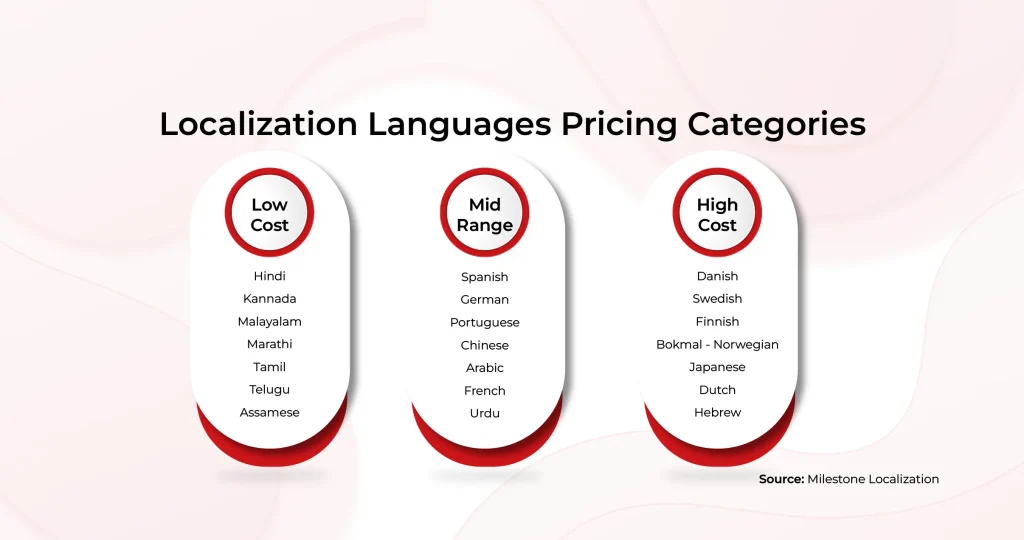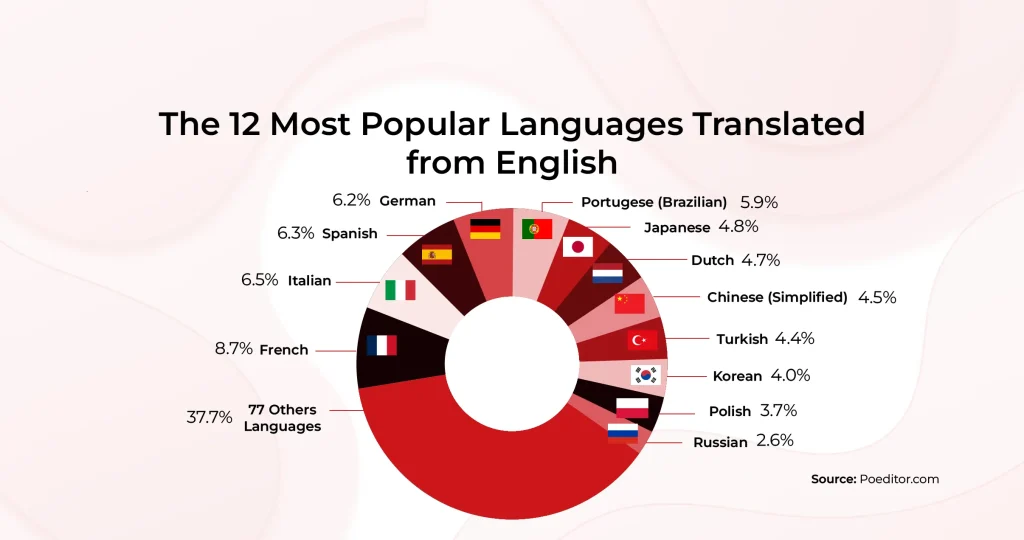Expanding your business into the global market is an exciting journey that opens up new opportunities and customer bases beyond familiar borders.
But successful international growth requires more than translating content; it calls for a smart localization strategy that speaks to the unique needs and cultures of your target markets.
So, how do you decide which localization languages will best support your business’s global expansion?
Rather than opting for a one-size-fits-all approach, the right choice should align with your business goals, product strengths, and target audience.
In this guide, we’ll explore essential insights and statistics on top localization languages and provide tips to help you choose the best languages to fuel your business growth worldwide.
Why Choosing Localization Languages Wisely Matters
Strategically selecting the right languages for localization can make all the difference between a successful global expansion and costly missteps. While it might seem tempting to prioritize widely spoken languages like Mandarin, Spanish, or Arabic, the decision should go deeper than numbers.
When you speak to your target audience in their native language, you’re not just translating your message—you’re building trust and credibility. Today’s consumers expect this level of personalization, and companies that thoughtfully choose their localization languages often see stronger market penetration and higher returns on investment.
On the other hand, selecting the wrong languages—or not localizing at all—can create barriers that leave potential customers feeling disconnected or even alienated.
So, what do you get when you choose the right localization languages for your business?
Factors to Consider When Choosing Localization Languages
Choosing the right languages for localization isn’t a matter of luck—it’s a strategic process that involves considering various important factors to tailor your expansion approach in a way that connects you more effectively with new audiences and ensures your brand resonates in each market.
Target Market Demographic
Gathering insights about your target audience and market regarding their language preferences and needs is a step that you must pay attention to.
While it’s imperative to identify your target market’s primary languages, other languages are sometimes used on digital platforms. For example, in many African nations, English and French might be used extensively online due to the influence of colonial history, but local languages are gaining traction.
Also, regional variations for each country should be considered. For example, while Latin American Spanish and European Spanish are mutually intelligible in Spain and Latin America, there are still differences in some vocabulary meanings, which can lead to misunderstandings.
Business Goals and Objectives
Understanding your business goals will help you prioritize which languages are essential for your specific objectives.
For instance, if you’re targeting emerging markets, consider local dialects that resonate more with the populace rather than relying solely on widely spoken languages.
If you’re tapping into the fast-growing Chinese market, you should know that there are two Chinese writing systems: traditional Chinese system and simplified Chinese. Arabic would be your best bet in Middle Eastern countries.
Language Complexity and Resources
Assessing your resources compared to the complexity of the target languages is another step that shouldn’t be overlooked. Sometimes, languages such as Chinese or Arabic require higher costs than others.
In most cases, businesses will need to get the support of a professional translation services company to have access to qualified translators, translation tools, and the needed cultural expertise to deliver high-quality localized content.
Cultural Sensitivity and Nuances
Understanding cultural nuances is a vital aspect of successful localization that goes beyond merely translating words. It involves adapting language and messaging to fit the cultural context of your target audience.
For instance, appropriate greetings and forms of address can significantly impact how your brand is perceived. In some cultures, using a formal title may be expected when addressing someone, while in others, a casual approach might be more appropriate.
Beyond Speaker Base Size: Other Factors to Consider
While a language’s popularity might suggest that its speaker base size is the only factor to consider, effective localization depends on much more. Many elements contribute to whether a language will help your brand thrive in a new market.
Market Saturation and Competition
Even in regions with a large speaker base, high competition can make it difficult to gain a foothold. In contrast, emerging markets with less saturation can offer valuable opportunities for growth, where a localized approach can help you stand out and attract a loyal customer base.
Payment Capacity and Purchasing Power
Markets may have large speaker bases, but if the general purchasing power is low, the potential return on investment might not justify the cost of localization.
Languages spoken in regions with high purchasing power—where customers are more likely to afford premium products or services—often yield better results, as consumers in these markets are typically willing to spend more if the content resonates with them.
Level of English Proficiency
In certain markets, localization may yield diminishing returns if a large portion of consumers are comfortable engaging with products or services in English. For instance, the Netherlands ranks among the highest in English proficiency, where many residents easily navigate English-language content. In such cases, investing heavily in localization for the local language may not be necessary, and using English could be a more efficient choice.
Prevalence of Other Languages
In many regions, multiple languages coexist, and certain languages may hold more significance than others.
For example, in countries like Canada or India, while English might be prevalent, local languages such as French or Hindi may hold cultural importance and be preferred for specific demographics.
Competitors’ Localization Strategies
Analyzing competitors can highlight effective strategies and illuminate potential opportunities for differentiation. Your competitors may have already targeted certain languages, allowing you to understand how those selected languages resonate with customers you might want to reach.
Also, if most competitors are neglecting specific languages or markets, seizing that opportunity might grant you a competitive edge.
The Most Popular Languages for Localization: Data and Insights
German
It’s spoken mainly in Germany, Austria, and Switzerland by over 130 million people. It’s essential for businesses working in the automotive, engineering, and finance industries.
French
French is the official language in 29 countries and is widely spoken by over 250 million people globally in regions including Europe, Africa, North America (notably Canada), and parts of the Caribbean and Asia.
With many prestigious fashion brands and events based in France, it’s one of the most popular languages for localization, especially for those who work in the Fashion industry.
Spanish
Spoken by over 500 million people, Spanish is spoken across 21 countries, including Spain, Mexico, Costa Rica, El Salvador, Guatemala, and Honduras.
It’s especially important for businesses specializing in agriculture, manufacturing, and food and beverage.
Italian
Italian is spoken by 60 million people worldwide. It’s one of the most popular languages for localization, mainly spoken in Italy, which is known for its high contributions to fashion and art.
Dutch
28 million people speak Dutch in Belgium and the Netherlands, which is known for its growing economy and its tech-savvy population.
E-commerce brands looking to expand their reach should prioritize localization in Dutch. The Dutch market is technologically advanced, with a high percentage of online shoppers reaching 78% of the population.
Japanese
With over 130 million people speaking Japanese worldwide, Japanese is the go-to language for game developers. Japan is dominating the video game industry.
Need help to select the best-suited localization languages for your business? AsiaLocalize has been in the translation and localization industry for over a decade, supporting thousands of clients entering the global market.
With the most qualified translators in your target language and industry and the most advanced technologies, we can lift the heavyweights, leaving nothing to chance.
| Break language and cultural barriers on your way to the international market. Contact Us Now! |









